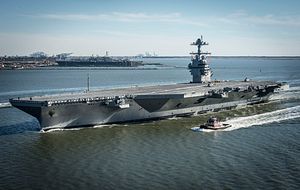The U.S. Navy’s long-delayed nuclear-powered Gerald R. Ford-class aircraft carrier USS Gerald R. Ford (CVN-78) has finally taken to sea for its first round of sea trials, known as builder’s sea trials, the U.S. Navy announced on April 8.
The sea trials are a first opportunity to test the ship’s various systems, components, and compartments at sea. “Over the next several days, CVN 78 sailors, shipbuilders from Huntington Ingalls Industries – Newport News Shipbuilding (HII-NNS), the Navy’s Supervisor of Shipbuilding, and Naval Sea Systems Command personnel will be working side-by-side testing many of the ship’s key systems and technologies,” the statement reads.
“The Navy and our industry partners are excited to have the future USS Gerald R. Ford underway under her own power for the first time, executing a rigorous and comprehensive test program for this first-of-class ship,” said Rear Admiral Brian Antonio, the U.S. Navy’s program executive officer for aircraft carriers. Prior to leaving port, the Ford’s crew has completed pier-side tests at Huntington Ingalls Industries shipyard in Newport News, Virginia during which the sailors aboard the ship simulate operating the carrier as if it were at sea.
The program appears to be on track for now and only slightly behind schedule. In January 2017, the U.S. Navy had scheduled builder’s sea trials for March, acceptance trials in April 2017, followed by delivery to the U.S. Navy in the same month. It is likely that the carrier’s delivery date will be pushed by a few days into May.
As I noted last week:
There is still no official commissioning date for the most expensive warship in U.S. Navy history. Total cost for the lead ship of a planned fleet of ten Ford-class carriers is estimated around $13 billion. The program’s cost overrun is more than $2.3 billion so far, which has drawn harsh criticism from congressional leadership including Senate Armed Services Committee chairman John McCain.
One of the reasons for the delay and cost overrun has been the installation of a number of new unproven systems such as the two main turbine generators and a new Advanced Arresting Gear (AAG) on the ship’s flight deck. Both the AAG and turbine generators experienced a number of technical problems. The ship’s new dual-band radar system and so-called Advanced Weapons Elevators also required additional testing.
The ship is expected to be commissioned this summer, although no official commissioning date has been announced so far. The USS Ford’s sister ship , the John F. Kennedy, is expected to be commissioned with a two-year delay in 2020.

































